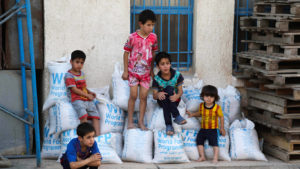

Alan Macleod – October 14, 2020
More than 55 million people in seven countries are in desperate need of COVID-19-related famine relief. That is according to a new report from international charity Oxfam, entitled “Later will be too late.” The report details how 55.5 million people in seven countries — Yemen, Afghanistan, Nigeria, Burkina Faso, the Democratic Republic of the Congo, and Somalia — are living in severe-to-extreme levels of food insecurity or even famine conditions, thanks largely to the fallout from the coronavirus pandemic.
In March, the United Nations called for $10.3 billion in emergency funding to deal with the worldwide humanitarian impact the pandemic was expected to bring. Unfortunately, it has received barely a quarter of what it has asked for from donors. Every sector, including gender-based violence (58 percent funded), protection (27 percent), health (27 percent), and water, sanitation and hygiene (17 percent) are chronically under-funded. But the worst underwritten parts of its coronavirus response plan are food security (11 percent) and nutrition (3 percent). Indeed, in 5 of the 7 countries noted, the UN has received nothing at all to deal with the crisis. Oxfam called the international community’s response “dangerously inadequate.”
“The Committee for World Food Security must raise the alarm at the UN that famine is imminent on its watch and not enough is yet being done to stop it. We need a fairer and more sustainable food system that supports small scale producers. Years of neglect mean that millions upon millions of people remain unnecessarily vulnerable to shocks like COVID, climate change and conflict,” said Oxfam’s International interim Executive Director, Chema Vera.
Official estimates suggest that around 1.1 million people have died from COVID-19 globally since its emergence in China late last year. While the United States has seen the most cases and deaths overall, it is now countries in the global south that are the most intense hotbeds of the virus, with Brazil, Mexico, and India right behind the U.S. There are currently over 800,000 active cases in India alone.



